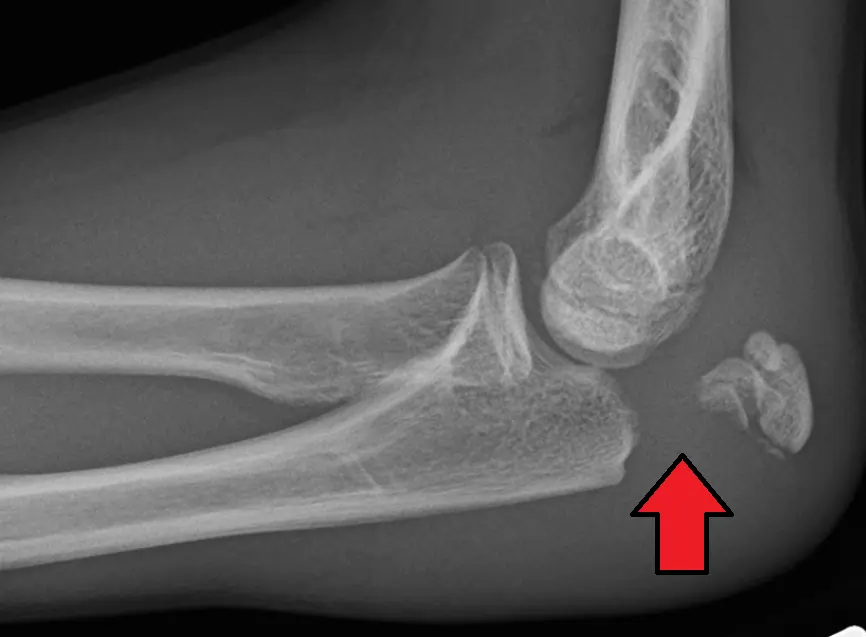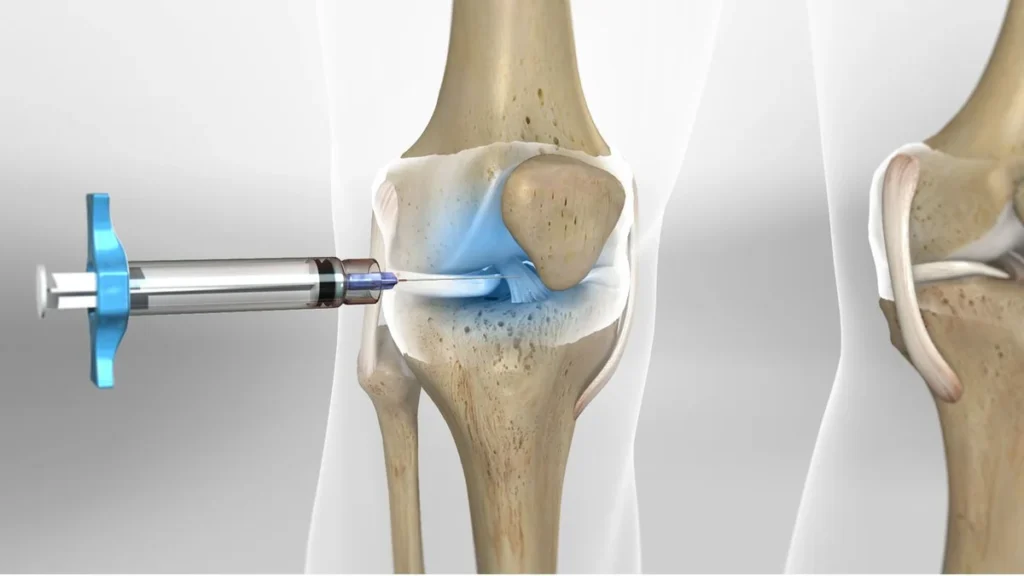In this article from the International Height Increase Center of Iran, we will discuss the olecranon elbow fracture.

Elbow Anatomy
Introducing the Olecranon Process: The olecranon process refers to the most prominent part of the elbow joint. When you bend your elbow, you can feel a firm bony prominence under the skin at the back of the elbow. This prominence is called the olecranon process, which is the upper part of the lower arm bone or ulna and plays a role in forming the elbow joint.
Formation of the Elbow Joint: The elbow joint is formed by three bones: the humerus (upper arm bone) at the top, and two forearm bones (the lower arm bone or ulna and the upper arm bone or radius) at the bottom. The ulna is located on the side of the little finger, and the radius is on the thumb side. The elbow joint has a hinge-like movement, meaning it moves in only one direction.
Ligaments of the Elbow Joint: On both sides of the elbow joint, there are ligaments that stabilize the joint. The ligaments on the outer part connect the humerus to the radius (upper arm bone), and the ligaments on the inner part connect the humerus to the ulna (lower arm bone).
Treatment of Olecranon Fractures
(You can add information related to the symptoms and treatment methods of olecranon fractures in this section.)
Mechanism of Olecranon Elbow Fracture
Direct Impact
Description of Impact: Fractures due to direct impact occur when a person falls to the ground with a bent elbow, and the elbow is the first point of contact with the ground. This situation can also include a direct and severe impact on the prominence at the back of the bent elbow.
Type of Fracture: In these types of impacts, usually, the fractures are comminuted and involve multiple pieces at the olecranon. The displacement of the broken pieces in these types of fractures is usually minimal.
Indirect Impact
Description of Impact: This type of fracture occurs when the patient extends their hand downwards before hitting the ground, straightening the elbow. This fracture occurs when the palm hits the ground, and the triceps muscle, which is attached to the olecranon process, contracts forcefully.
Type of Fracture: In this mechanism, usually, a large piece of the ulna bone breaks off, and the amount of displacement at the fracture site is usually significant.
Symptoms of Olecranon Elbow Fracture
Pain and Swelling
Sudden Severe Pain: This type of pain usually occurs at the moment of the fracture. Swelling: Swelling is typically observed over the olecranon process.
Bruising and Pain During Movement
Bruising: This occurs in the elbow area following a fracture. Pain During Elbow Movement: Increased pain during elbow movement is indicative of a fracture.
Scratches and Wounds
Scratches or Wounds: In cases of fracture due to direct impact, scratches or wounds may appear on the skin over the olecranon process.
Displacement of Bone Fragments
Palpable Gap: In fractures that are single-piece with significant displacement, a gap between the broken fragments may be palpable through the skin. Loss of Ability to Straighten the Elbow: In single-piece fractures with significant displacement, the patient usually cannot straighten or keep their elbow straight. In multi-fragment fractures, this ability might be preserved.

To make an appointment or get an online consultation with Dr. Nader Motallebi Zadeh, Limb lengthening surgeon, proceed here.
Treatment of Olecranon Fractures in the Elbow Joint
Treatment Methods for Olecranon Elbow Fractures Treatment of olecranon fractures in the elbow is done in two ways: non-surgical and surgical.
Non-surgical Treatment
If there is no displacement of the broken fragments, the use of a splint is recommended for treatment. In this method, the patient’s elbow is placed in a splint for 3 to 4 weeks to heal.
During this period, weekly assessments through imaging of the elbow are performed to prevent any secondary displacement at the fracture site.
After a few weeks, the splint is removed, and the patient must perform specific exercises for an extended period to restore the elbow’s range of motion to its original state.
Surgical Treatment
In cases of displaced fractures or open fractures, surgery is chosen as the treatment method for the olecranon.
Surgery is performed using an open method, which includes anesthetizing or numbing the patient, creating an incision at the back of the elbow by an orthopedic surgeon, moving aside the muscles, and fixing the broken bones using metal devices such as pins, wires, screws, and plates.
After surgery, elbow movement should start as soon as possible. Usually, on the day after surgery, the treating physician advises the patient to begin elbow movements.
These exercises should be performed several times a day under the supervision of a doctor or physiotherapist. Delaying the start of these movements can make the return of the elbow’s range of motion more difficult.
The patient should not lift any object with the injured limb for about six weeks. Usually, after four months, the patient can return to the level of activities before the fracture, but the recovery process can take up to a year, and performing intense physical activities may only be possible after this period.
Success in recovery within the mentioned times depends on the patient regularly performing the elbow movements and exercises.
In cases of comminuted fractures of the olecranon process, if the fragmentation is so severe that fixing the broken fragments is not possible, the surgeon usually removes the fragments and attaches the triceps tendon to the remaining ulna bone.
Complications of Olecranon Elbow Fractures
Elbow Joint Movement Limitation
One common complication of olecranon elbow fractures is limited mobility in this joint. Accurate and timely execution of movements recommended under the supervision of a specialist doctor or physiotherapist is extremely important. Sometimes, a minor limitation in fully extending the elbow after a fracture occurs, but this usually does not significantly impact elbow function or the performance of heavy physical activities. If the limitation of elbow movements becomes severe, treatments such as special exercises and sometimes surgery are recommended.
Non-union of the Fracture
In cases where the distance between broken fragments is large or they are not properly immobilized together, there is a possibility of the fracture, not healing (non-union). In this situation, the space between the broken parts fills with fibrous tissue. Although the patient’s pain goes away and the elbow can move, the elbow’s strength is reduced. In older individuals who do not require much physical strength, this condition may not need treatment. Conversely, younger individuals should undergo surgery to remove the fibrous tissue and fix the broken pieces together with screws or other devices.
Malunion of the Fracture
If the broken fragments do not align properly in their anatomical position, they may heal incorrectly (malunion). This condition can lead to arthritis in the elbow joint over the long term. In young people, if the bone displacement at the site of malunion is significant, surgery to reposition the bones correctly and fix them with screws or other devices is necessary. In older people or cases with minimal displacement, surgery may not be required.
Wear and Tear or Arthritis of the Elbow Joint
Wear and tear of the elbow joint is another complication of olecranon fractures. This condition can cause pain and limited mobility in the elbow, although usually, this pain and limitation are mild. The cause of this condition is damage to the broken bone or the cartilage on the joint surface. If the broken bones do not align properly and the joint surface becomes uneven after healing, it can lead to arthritis in the long term.
However, it’s not just the condition of the bones that determines the future of the joint; even if the broken pieces heal correctly, if the joint cartilage was damaged at the time of the accident, there is a possibility of developing arthritis in the elbow. It should be noted that not all elbows that suffer an olecranon fracture develop osteoarthritis, and not all patients who develop osteoarthritis experience pain and limited mobility.

To make an appointment or get an online consultation with Dr. Nader Motallebi Zadeh, Limb lengthening surgeon, proceed here.



